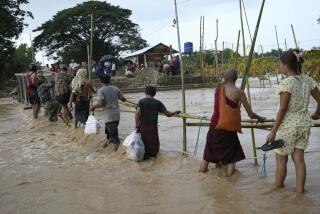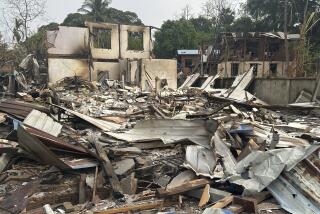Scavenging for a meal of rotten rice
YAWAR THAR YAR, MYANMAR — The search for food begins just after dawn.
Each day, men, women and children fan out into paddies flooded by seawater, littered with corpses. Like prospectors working claims, they scoop up the muck in their bare hands and finger through it for grains of unmilled rice swept away by the cyclone.
When their luck is good, they discover red chile peppers or small onions in mud reeking of the dead. Then, they can have condiments with their next meal of rotten rice and coconut meat.
For more than three weeks now, the 149 survivors of Tropical Cyclone Nargis in this village have been living like stranded scavengers among the ruins of their own homes and the decomposing remains of their relatives. Ninety-one of them died in the storm.
Myanmar’s military government, which has a relief hub just 10 miles north in the town of Bogalay, has not delivered aid to scores of remote villages like this across some of the most devastated areas of the Irrawaddy River delta. For now, the villagers’ only hope is goods that arrive from time to time in an underground supply chain operated by Buddhist monks in Bogalay, who are defying the ban on private relief operations in the delta.
Monks say the government has loaded some of the villagers into trucks and shipped them off to work on forced labor projects.
Those who remain, once proudly self-sufficient rice farmers, have become desperate hunter-gatherers, scrounging in the dirt and debris.
“Now the only job for everyone in the village is searching for something to eat,” said Ko Sein Lwin, 45, who before the cyclone hit was able to keep three daughters in a university, at $500 each per year.
“We’re starting out life again, not from the first step, but from zero,” he added grimly. “It’s like going back to the Stone Age.”
The death toll has continued to rise, to an official count of about 78,000, as this Southeast Asian nation struggles with the effects of the May 2-3 storm. An additional 56,000 people are missing.
United Nations Secretary-General Ban Ki-moon said Senior Gen. Than Shwe had assured him Friday that relief workers from any country would be welcome. But the regime has made no announcement itself.
It has said it needs $11 billion for reconstruction. But about 50 donor nations, including the United States, have made firm commitments for only $100 million, in part because of widespread distrust of the generals.
As the government tried to coax more aid from donors Sunday at a conference in Yangon, the country’s principal city, Buddhist monks in Bogalay were secretly organizing six boats to carry out their next unauthorized relief mission.
After evicting thousands of people from Bogalay’s relief camps, the government is trying to cut off the monks’ aid to delta villages, said a local abbot, who is a leader of the underground effort.
He spoke on condition he not be named, fearing military reprisals against him and the relief operation, which thousands of survivors in remote villagers are depending on for support.
When they can, the monks gather donations secretly because authorities insist that all aid must be channeled through the military. On May 19, when private donors tried to deliver a few truckloads of supplies to the abbot’s monastery, security forces attempted to turn them back.
“All the soldiers and police locked arms and blocked the street in front of our monastery,” he said, as a military helicopter hovered before landing across the river. “The driver panicked, so I pulled him out and drove myself, shouting through a loudspeaker, ‘Get out of the way or I’ll hit you with the truck!’ ”
The abbot showed video, which he said a colleague shot with a camera hidden under his maroon robes, to support claims that the military is evicting cyclone survivors from private relief camps.
In one video, a soldier slaps an elderly woman in the face with a paper listing the names of the expelled. She was pleading for permission to stay in a Hindu temple over the weekend, the monk said. It was the last of several private relief camps operating before authorities closed it, he said.
“Most of these refugees are not educated,” said the abbot, trying to explain the soldiers’ disdain for the villagers. “They don’t even know how to sign their names. They just use fingerprints. So the military thinks they’re not human.”
The evictions have resulted in a number of deaths, the abbot said. Dozens of survivors died May 18 when three riverboats capsized in a storm as they were heading back to villages flattened by the cyclone, he said.
Military officers told those returning to their destroyed villages to sign forms that said they were doing so willingly, the abbot said.
Soldiers herded thousands more onto trucks to be taken north to Mo Oo Pin, where they are being forced to make jute and do roadwork for less than $1 a day, the abbot said.
He said some of the laborers had made their way back into Bogalay under cover of darkness to ask the monks for food.
In another video, people who look scared and speechless, some crying, are loaded onto a large military truck in front of a monastery as an army officer with stars on his epaulets supervises. Two other soldiers stand nearby, apparently compiling lists of the storm survivors’ names.
The U.N., the U.S. State Department and human rights groups have long accused the military regime that rules Myanmar, also called Burma, of using forced labor for road building and other projects. Activists who speak out against forced labor are routinely jailed.
The abbot said 36 monks are running the underground relief effort, along with 10 volunteer doctors and 20 village navigators who help them maneuver through the delta’s network of rivers and canals to elude patrol boats and reach isolated villages.
“We’re preparing for a confrontation,” the monk said. “If they try to close us down, we’re prepared to fight.”
Echoing accusations made in other parts of the disaster zone in recent days, the monk said local authorities were providing barely enough basic food for storm victims to survive, while hoarding the rest for profit.
“They are selling the most valuable things to businessmen in Chinatown,” he charged.
Sein Lwin’s village is half an hour’s walk from the closest river, so the monks’ boats, and other unauthorized relief operations, don’t reach it.
When the boats make their quick stops with aid at a nearby village, Sein Lwin and his neighbors must ask for a share of the fresh supplies. They make do with what other destitute survivors are willing to give up, usually just 2 cups of rice per person each day.
Cash savings disappeared in the cyclone-driven surge of waves at least 8 feet high that raced through the village. Gaping holes in Sein Lwin’s roof are patched up with pieces of tarp that he dragged from the river as they floated past after the storm.
The cyclone smashed a brick and cinder-block primary school to rubble. All of the books are gone, and no one has heard from the teachers, who live in Bogalay and were scheduled to start classes again on June 1 for 80 students.
Many of Sein Lwin’s neighbors have rashes from washing in filthy water. Eight adults in the next village have diarrhea.
So far, they’re coping with antibiotics, but villagers said they fear health problems will get worse the longer they live in such primitive conditions.
When a visitor asked why the regime would refuse to help so many people like him, Sein Lwin stared blankly ahead. More than 20 villagers in the room with him sat in uncomfortable silence. They were afraid to speak their minds.
More to Read
Sign up for Essential California
The most important California stories and recommendations in your inbox every morning.
You may occasionally receive promotional content from the Los Angeles Times.










